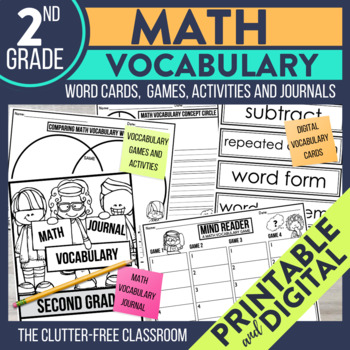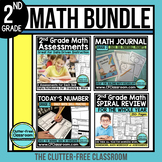Math Vocabulary Games, Cards, Journals and More for 2nd Grade
- Zip
- Google Apps™
- Internet Activities

What educators are saying
Also included in
- This 2nd grade math bundle includes math assessments, journals, spiral review activities and more. It's a huge collection of printable and digital math activities to use with your second graders! With this resource you'll have a go to library of resources to save you tons of time planning and preppiPrice $149.00Original Price $270.88Save $121.88
Description
These 2nd grade math vocabulary games, cards, journals, and activities are an essential part of best practice math instruction. In many ways, learning math is like learning a foreign language. In order to be successful in math, students must become fluent with the math vocab.
This second grade vocabulary packet includes tons of printable and digital resources to help you support your students in learning your grade level’s math language and being comfortable enough to use it in academic conversations.
WHAT IS INCLUDED:
✓ math vocabulary journal that encourages students to write about math concepts using grade level vocabulary and serves as a reference tool students can access independently
✓ math vocabulary cards that can be used for a math word wall or instructional tool
✓ 7 printable games and activities that encourage students to explore and practice math vocabulary
✓ digital versions of all the resources so students can access them in school or at home
5 REASONS TEACHERS LOVE THIS RESOURCE:
► All of the resources are available in printable and digital formats, so students can access them online and in-person.
► This resource packet is comprehensive as it includes math vocabulary cards, journals, games, and activities, so it will save you lots of time looking for quality resources.
► The resources help students build a deeper understanding of math concepts and skills by providing numerous opportunities to engage with the vocabulary.
► The vocabulary games, activities, and journal templates can be used over and over again throughout the year so students quickly learn the format and routine, which helps you maximize your teaching time.
► The vocabulary word cards are digital, editable and printable, so you can customize them to fit your needs.
VISIT OUR LET'S GET CONNECTED PAGE TO CHOOSE FROM . . .
◼️THE EMAIL CLUB → weekly freebies
◼️FACEBOOK GROUP → a supportive community of elementary teachers
◼️THE TPT STORE → new resources 50% off
◼️THE BLOG → teaching tips and ideas
◼️INSTAGRAM → a look behind the scenes






